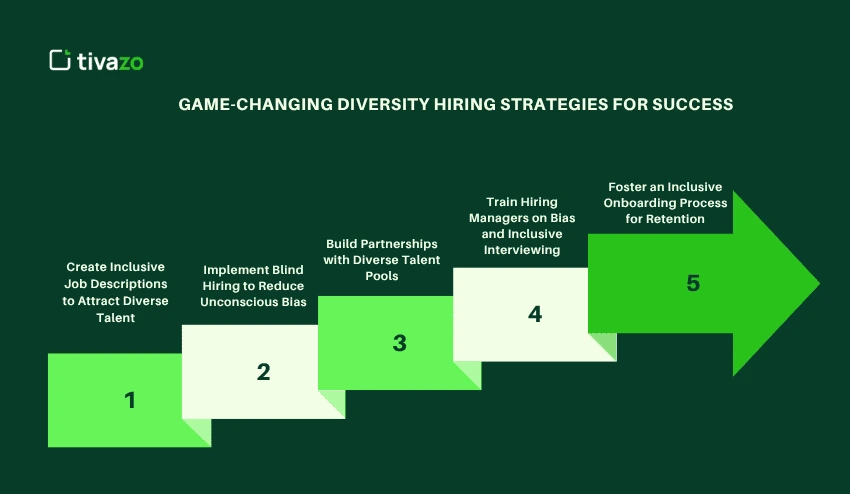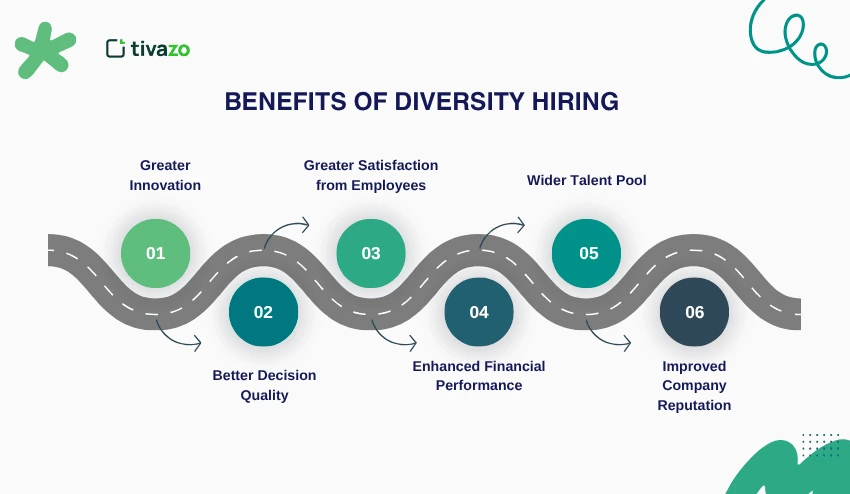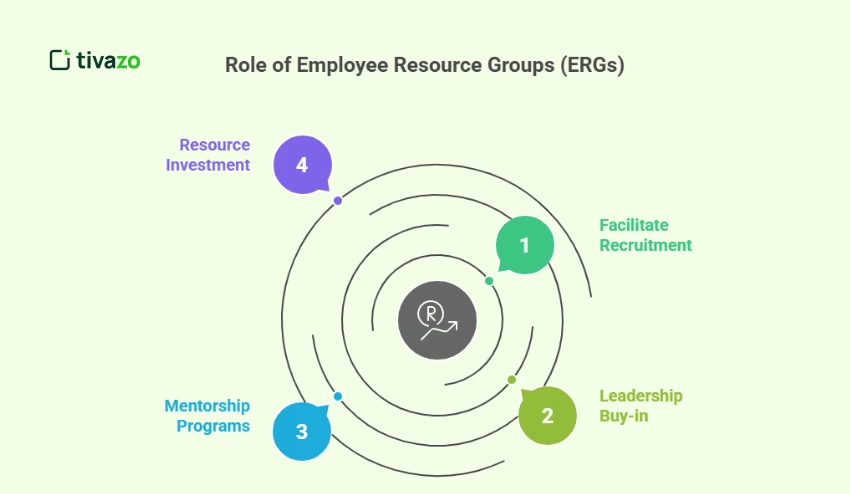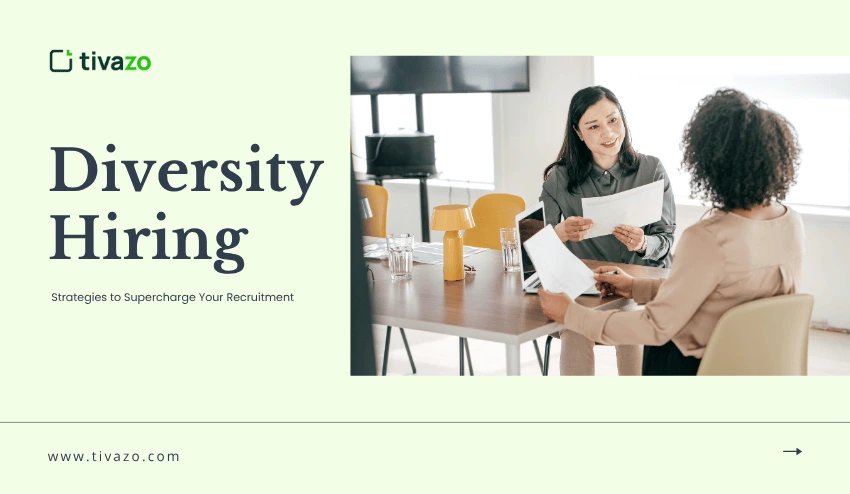Diversity hiring is not a fad; it is a revolution! Businesses are realizing the benefits of diversity as a means of innovation, improving employee engagement, and strengthening productivity in a globalized world. Thus, it is no surprise that diversity hiring is a fundamental element for organizations to remain competitive.
But how can businesses implement diversity hiring practices that result in actual positive change? In this guide, we will delve into the top 5 diversity hiring the impact strategies that can help you reinvent your hiring process and build better, more inclusive teams.
If you are ready to start attracting high-level talent and building better, more inclusive workplaces, you won’t want to miss this blog.
Key Highlights:
- Impact of Diversity Hiring on Your Organization
- Diversity Hiring Strategies for Success
- Common Challenges in Diversity Hiring
- Benefits of Diversity Hiring
- Impact of Remote Work on Diversity Hiring
- Role of Employee Resource Groups (ERGs)
Understanding the Impact of Diversity Hiring on Your Organization
Diversity hiring is not only the right thing to do, it’s a business strategy as well. When implemented well, diversity hiring strategies can drive innovation and increase employee engagement and business outcomes. Diverse teams bring additional perspectives to the collaborative process, which will ultimately create innovative solutions and products that will have a global audience. This is why organizations embracing diversity consistently outperform their competition, sure by the drive to innovate.
In addition, diversity in hiring leads to employee engagement and feelings of value and belonging in a workplace. When diverse teams are engaging in collaboration, there is no lack of ideas, experiences, and input for each decision. McKinsey’s research shows that firms with women and racially diverse workforces are 35% more likely to achieve financial returns above their national industry median. Yet, anecdotally, the benefits of prioritizing diversity hiring are obvious from a culture perspective and aren’t just popular opinion.
5 Game-Changing Diversity Hiring Strategies for Success
Now that we have noted the importance of diversity hiring, we can dive into the 5 strategies that will enhance your entire hiring process.

1. Create Inclusive Job Descriptions to Attract Diverse Talent
The first step in diversity hiring is ensuring the specific job descriptions you write are inclusive and welcoming. There should be no relevant criteria, but only the skills and qualifications that matter, selectively included and chosen. A known fact: inclusive language is important to ensure certain groups aren’t unintentionally excluded. Terms like ambitious, competitive can be replaced by team-oriented or collaborative terms that can bring in a whole new group of applicants.
Revision tools like Textio can help you with job descriptions that are free from bias and more inclusive, hoping to recruit a diverse talent pool. Inclusion in enlivening job descriptions should help candidates from a range of backgrounds feel more inclined to apply; this task is vital for diversity hiring overall.
2. Implement Blind Hiring to Reduce Unconscious Bias
Blind hiring is a technique that allows organizations to mitigate any form of unconscious bias when hiring individuals. When using blind resumes, identifying information such as name, gender, and educational institution is removed from candidate resumes. Therefore, hiring organizations can evaluate each candidate based on the skills and qualifications they bring to the organization. The goal of blind hiring is to eliminate any type of bias and influence that may impact hiring decisions. This form of recruitment can lead to a more diverse pool of candidates.
Research shows blind hiring is effective in encouraging diversity in the hiring process since it eliminates bias and assumptions that may inhibit hiring candidates from underrepresented communities. In a blind hiring process, the focus is on merit or the merit of the interest group, not the background or irrelevant characteristics of a candidate.
3. Build Partnerships with Diverse Talent Pools
Partnering with organizations, platforms, and job boards that focus on a diverse pool of talent is crucial to your diversity hiring efforts. Partnering with job boards focusing on minorities with other core professional organizations is key to reaching talented and diverse candidates that might not be reached in traditional recruitment efforts.
Sites like PowerToFly and Black Career Network are incredible resources to discover different candidates. Partnering with these organizations can help your company attract diverse talent and become recognized as an inclusive employer with an interest in diversity and inclusive recruitment.
4. Train Hiring Managers on Bias and Inclusive Interviewing
Training hiring managers to be aware of and remedy unconscious bias is important in ensuring that they create a fair and inclusive selection process. Hiring managers are key players in diversity hiring, and once they are trained, they will assess candidates much more equitably.
Inclusive interviewing consists of techniques and processes that will help hiring managers conduct fair and balanced interviews. By understanding that bias can impact decision making, hiring managers will be able to make decisions on objective criteria, which will encourage a more inclusive recruitment process to attract and retain candidates with diverse talent.
5. Foster an Inclusive Onboarding Process for Retention
Not only do you want to attract a diverse set of candidates, but you want to retain them. A welcoming and inclusive onboarding process signifies to new employees from underrepresented backgrounds that they are valued and will have support. It should focus on helping new hires assimilate into the culture of the organization while providing mentorship and support from the very first day on the job.
Offering employee resource groups and ongoing training as well can help new hires embrace inclusivity and allow new hires to connect with their peers. By creating an inclusive onboarding experience, you increase the probability of retaining your diverse hires, and the success of your diversity hiring practice will become apparent.
How Technology Is Shaping Diversity Hiring
In today’s digital world, there are undeniably some exciting new solutions that assist and enhance diversity hiring initiatives. AI-powered hiring tools and diversity recruitment tools are making it easier to attract, assess, and hire diverse talent.
Hiring tools like HireVue, Pymetrics, Greenhouse, and more will help to create a smooth and equitable view of the hiring steps. These tools will allow organizations to assess candidates and collect information based on skills, not demographics, so they can make a hiring decision based on merit.
Addressing Common Challenges in Diversity Hiring
Diversity hiring can be transformational, but it is not without obstacles. Some common challenges are:
- Bias in the Recruitment Process: Even with blind hiring and descriptions for inclusive jobs, bias still exists.
- Resistance to Change: Some organizations are unwilling to implement diversity hiring strategies for fear of losing existing employee trust or disrupting the status quo.
- Lack of Diverse Talent: Some industries, especially tech and finance, might fail to find diverse candidates.
These challenges can be managed through effective leadership, a focus on change, and strategic approaches.
The ROI of Diversity Hiring: Why It’s Worth the Effort
The ROI around diversity hiring is clear and indisputable. Diversity in the workplace is associated with being more innovative, productive, and profitable than non-diverse competitors.
Additionally, the reputation when you embrace diversity increases the likelihood of top talent choosing your organization. With diversity on the minds of employees and consumers alike, companies with a reputation for hiring diversity will have an advantage over those that do not. The ROI is reflected in better financial performance and engaged, innovative employees.
Benefits of Diversity Hiring
Benefits of Diversity Hiring:

- Greater Innovation: Diverse teams have divergent perspectives, which result in different, creative solutions and innovative products.
- Better Decision Quality: A wider range of perspectives brings about better-balanced decisions.
- Greater Satisfaction from Employees: Inclusive workplaces offer employees a feeling of belonging, which leads to greater job satisfaction and lower turnover rates.
- Enhanced Financial Performance: Some companies with diverse teams are 35% more profitable than their peers (McKinsey).
- Wider Talent Pool: Global reach gives you access to a wider range of perspectives and skill sets, elevating your hiring standard.
- Improved Company Reputation: Companies recognized for diversity hiring will attract elite talent, as well as boost their employer brand as “inclusive employers.”
The Impact of Remote Work on Diversity Hiring
Remote work has revolutionized diversity hiring, allowing companies to hire from anywhere across the globe, breaking down physical barriers to recruitment. This allows for many, many candidates, and is not limited to finding diverse candidates locally, which may not help significantly to improve the diversity of the group’s candidate pool, allowing for increased diversity to be hired into their teams.
However, diversity hiring remotely has a challenge of inclusivity with multiple time zones in considering of inclusivity and differences in cultures, which could create misunderstandings.
Companies can also consider using virtual onboarding as a way to allow remote hiring is one way to help feel integrated; remotely mentoring for connection; finding flexible work hours; being good practice for communication, and exploring other approaches to promote diversity hiring more inclusively in a remote working environment.
The Role of Employee Resource Groups (ERGs) in Supporting Diversity Hiring
Employee Resource Groups (ERGs) are vital to developing diversity hiring and building an inclusive environment. ERGs provide support and community to employees from underrepresented backgrounds and can be instrumental in recruiting talent from underrepresented backgrounds.

- Facilitate Recruitment: ERGs can work with HR to identify and actively recruit candidates from underrepresented groups, creating a broader and diverse talent pool. ERGs can also support the development of partnerships with universities or minority groups as a way to help attract diverse candidates.
- Leadership Buy-in: ERGs need leadership qualities to be effective. Leaders should provide resources, time, and attention to ERGs to ensure ERGs are supported and seen as part of an overall diversity hiring strategy.
- Mentorship Programs: ERGs support the provision of mentoring to employees with historically underrepresented backgrounds to foster a supportive community and allow diverse employees to grow within the organization. This helps to develop better-supported employees that has also been shown to increase employee retention at the organization and a more diverse leadership talent pool.
- Resource Investment: If companies want their employee resource groups (ERGs) to be effective, they need to put their money (funding), time, and people behind them. ERGs will need support to run events, connect with employees, and work towards their diversity goals.
Conclusion: Make Diversity Hiring Your Competitive Edge
Diversity employment is not just an option anymore in the competitive job market of today, but a necessity. The 5 strategies for really shaking up your diversity hiring, which I shared in this post, will help you attract talent, create an inclusive workplace culture, and result in sustainable long-term success for your business.
While you can start small, you will want to track your progress to make sure diversity is embedded in your organization’s DNA. The benefits are clear, and the results can be revolutionary!
Call to Action: I would love to hear your thoughts in the comments below. How has diversity employment changed your organization? Let’s continue the conversation!




